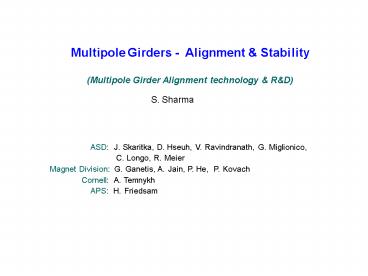Multipole Girders Alignment
1 / 17
Title: Multipole Girders Alignment
1
Multipole Girders - Alignment
Stability (Multipole Girder Alignment technology
RD)
S. Sharma
ASD J. Skaritka, D. Hseuh, V.
Ravindranath, G. Miglionico,
C. Longo, R. Meier Magnet Division G.
Ganetis, A. Jain, P. He, P. Kovach
Cornell A. Temnykh APS H.
Friedsam
2
Outline
- Alignment Technique and RD
- Reference Designs of the Magnets
- Mechanical Stability of the Multipole Girders
- Summary and Conclusions
Multipole Girder with Stretched Wire
3
Magnet Alignment Technique
Alignment tolerances Magnets 30 µm, 0.2 mrad
Girders 100 µm, 0.5
mrad
- Magnet alignment will be done with a vibrating
wire alignment technique developed at the Cornell
University by Prof. Alexander Temnykh.
4
Magnet Alignment Procedure
- Accepted magnets and vacuum components shall be
assembled (roughly aligned) on to the girder in
an assembly station. - The girder assembly will be moved and installed
into the temperature-controlled ( 0.1 ºC)
alignment facility. - The girder will be aligned using a laser tracker.
All electrical and water connections will be made
to the magnets. - Magnet movers are installed beneath each magnet.
- Magnet coils will be brought to their operating
temperatures.
5
Magnet Alignment Procedure contd.
- A clean wire will be inserted through the vacuum
chamber. - The wire will be secured to wire movers located
at either end of the girder assembly and a
controlled constant tension will be applied. - A Laser tracker will used to locate the two ends
of the wire at the correct height relative to
survey targets on the girder to within /- 100
microns.
6
Magnetic Alignment Procedure contd.
- The magnets and the stretched wire shall be
systematically powered. - Resultant wire vibration shall be monitored and
analyzed. - The wire height can be adjusted vertically by the
wire mover to correct for wire sag at each magnet
location along the girder and can be reproducible
to /- 1 micron. - The magnet movers shall be used to locate the
magnetic center of each quadrupole and sextupole
to the wire to lt25 microns
7
Vibrating Wire Technique - RD
Wire Mover
Magnet Mover
Experimental Setup (Magnet Division)
- Magnets will be setup will be on an existing 15
ft. granite surface plate. - The wire movers will be mounted on two small
separate granite surface plates on either side of
the magnet setup. - The wire movers will be 22 ft. apart.
- SLS magnets are on site. Design work to mount
them on magnet positioners will begin soon.
8
Vibrating Wire Alignment RD
Wire Mover
- Detailed design of major components are well
under way. - Wire movers, magnet positioners and 3 Motorized
X/Y Stages on order. - One set of 4 indicators with 1 um resolution is
available. - Cornell data acquisition system has been
duplicated.
9
Vibrating Wire Alignment RD contd.
10
Girder Alignment
- Approach
- (1) Use precise alignment mechanisms that are
removable. - (2) Simple hardware to lock the components in
place ? - stiff system with high natural frequencies.
- lower and predictable thermal deformations.
11
Storage Ring Multipole Magnets
Quadrupole Magnet
Magnet designs must be robust. Field quality
(harmonic contents) should remain within
specified tolerances after repeated disassembly
and reassembly. Several different designs
(SPEAR, SLS, APS) are being evaluated. A
2-segment sextupole design is being developed.
12
Storage Ring Multipole Magnets
Sextupole Magnet
A 2-segment sextupole design is being developed.
13
Mechanical Stability of the Multipole Girders
Tolerances on Magnets Motion
- Thermal relative thermal displacement between
magnets on the same girder lt 0.025 µm. - Vibration no magnification of ambient floor
motion up to 50 Hz. - Below 4 Hz girder motions are highly correlated
- Above 50 Hz the rms floor motion is lt 0.001 µm
14
Thermal Deformations
Magnets Relative displacement on a girder 0.01
µm Vacuum Chamber Near fixed and flexible
supports (SS plates) 0.3 µm
- Chamber deformations near the supports are
0.17 µm with Invar plates. - BPMs need to be located near the fixed or
flexible supports.
15
Ambient Floor Motion
RMS Displacements at CFN ( 0.5-4) Hz 200
nm (4-50) Hz 20 nm (50-100) Hz 0.4 nm
16
Mode Shapes of the Girder-Magnets Assembly
17
Summary and Conclusions
- The magnets on the girder will be aligned with a
vibrating wire technique. - Girders will be aligned with precise but
removable alignment mechanisms. - Reference designs for the SR magnets are being
developed that are consistent with the vibrating
wire alignment technique. - The multipole magnets-girder assembly (with
removable alignment mechanism) will meet the
stability specifications.































